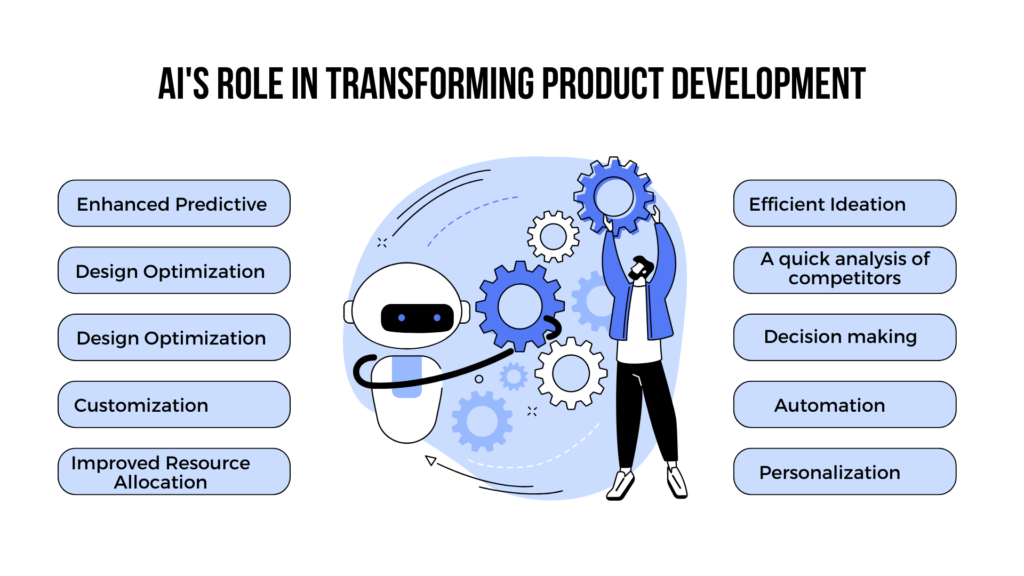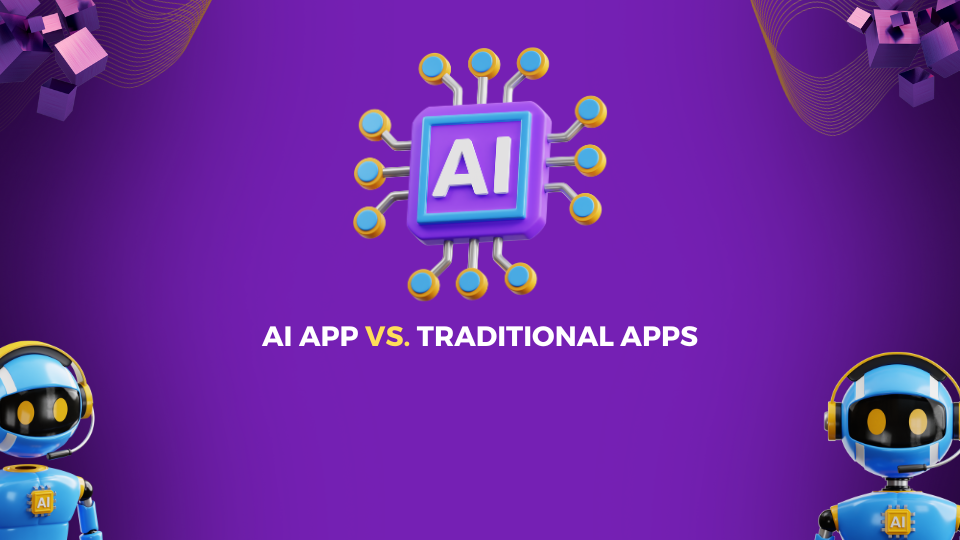landscape, artificial intelligence (AI) has emerged as a transformative force, revolutionizing various aspects of business processes. One of the areas experiencing significant disruption is the product development process. Integrating AI into this process leads to higher efficiency, improved resource utilization, and enhanced product outcomes. As of today, AI has already made remarkable contributions to reshaping how products are conceived, designed, tested, and brought to market. This article delves into how AI is reshaping the product development process, its benefits, and the implications for businesses and entrepreneurs in the ever-competitive global market.
AI’s Role in Transforming Product Development:
1. Enhanced Predictive Insights for Market Fit:
AI has empowered businesses with advanced data analysis capabilities to predict product-market fit more accurately. By analyzing vast datasets, including market trends, customer preferences, and competitive offerings, AI assists businesses in generating a range of innovative ideas and concepts. This proactive approach minimizes the risk of poor product-market fit, historically leading to many startup failures.
2. Efficient Ideation and Design Optimization:
AI has streamlined the ideation and design phases of product development. It facilitates rapid generation of design iterations, optimizing each stage of the development life cycle from planning and designing to testing and deployment. This acceleration reduces time-to-market and empowers developers to experiment with a wide array of design alternatives, fostering innovation.
3. Real-time Feedback Loops:
One of the transformative aspects of AI is its ability to enable real-time feedback loops throughout the product development process. By collecting user feedback, behavior data, and market responses, AI provides valuable insights into prototype strengths and weaknesses. This iterative learning process guides prototype development toward optimal outcomes.
4. Customization and Personalization:
AI-driven tools can analyze user behavior and preferences, allowing developers to tailor products to individual user needs. This customization enhances user experiences and increases customer satisfaction, driving better product adoption and loyalty.
5. Improved Resource Allocation:
Through AI-driven optimization, businesses can make more informed decisions about resource allocation. AI analyzes historical data and current trends to suggest efficient allocation of resources, ensuring optimal utilization and cost-effectiveness.

AI’s Role in Product Development
Benefits and Future Implications:
Incorporating AI into the product development process yields numerous benefits for businesses and entrepreneurs, including increased efficiency, reduced costs, and improved product quality. Moreover, AI opens new possibilities regarding product features, designs, and user experiences. AI technology is expected to play an increasingly central role in reshaping how products are conceptualized, developed, and delivered to the market. Companies that embrace AI in their product development journey are poised to gain a competitive advantage in an ever-changing business landscape.
Risks of AI in Design and Product Development
Integrating artificial intelligence (AI) into the design and product development process has ushered in a new era of innovation and efficiency. However, this technological advancement also brings forth challenges and risks that must be carefully considered and managed. As of the current date, here are some of the critical risks associated with the use of AI in design and product development:
1. Data Privacy and Security Concerns:
The utilization of AI involves collecting, analyzing, and interpreting vast amounts of data, including sensitive customer information. This raises concerns about data privacy and security, as the mishandling of such data could lead to breaches, unauthorized access, and potential legal ramifications. Organizations must implement robust cybersecurity measures to safeguard the data processed by AI systems.
2. Ethical and Bias Issues:
AI algorithms are trained on historical data, which may contain inherent biases. These biases can lead to discriminatory or unfair outcomes in product design and development, perpetuating existing social inequalities. It is crucial for developers to actively address and mitigate bias through comprehensive testing, ongoing monitoring, and ethical AI design practices.
3. Lack of Human Creativity and Intuition:
While AI can automate certain aspects of the design process, it may lack the intuitive and creative insights that human designers bring to the table. Overreliance on AI-generated designs could result in products that lack originality, uniqueness, and emotional resonance with consumers. Striking the right balance between AI-driven automation and human creativity is essential.
4. Limited Understanding of Context:
AI systems may struggle to understand complex contextual nuances, leading to misinterpretations or errors in design decisions. This limitation becomes evident when dealing with intricate design requirements or unique customer preferences that require human judgment and comprehension.
5. Integration and Adoption Challenges:
Incorporating AI into existing product development workflows can be challenging. Organizations may face difficulties integrating AI technologies with legacy systems, requiring substantial investments in training and infrastructure.
6. Overemphasis on Technical Feasibility:
AI’s predictive capabilities can sometimes overshadow considerations related to market demand and user needs. Relying solely on AI-generated insights without proper validation from user feedback and real-world testing may result in products that fail to resonate with the target audience.
7. Unpredictable AI Behavior:
The complexity of AI algorithms can lead to unpredictable behavior in specific scenarios, making it difficult to fully understand how an AI system arrived at a particular design recommendation or decision. Ensuring transparency and explainability in AI-driven design processes is paramount.

Risks of AI in Product Design
Genius AI Services
Developing an AI product involves several key steps and considerations. Whether you’re creating a software application, a hardware device, or a service powered by AI, the following steps can serve as a general guide. We at Genius AI are with you every step of the way.
Idea Generation and Conceptualization:
Identify a specific problem or opportunity that can be addressed using AI technology. Brainstorm and refine your product concept, considering its unique features, benefits, and potential user base.
Market Research:
Conduct thorough market research to understand your target audience, their needs, and existing solutions. Analyze competitors to identify gaps in the market that your AI product can fill.
Feasibility Assessment:
Determine the technical feasibility of your AI product idea. Assess whether the required AI technologies and resources are available or can be developed.
Data Collection and Preparation:
AI products often require large and high-quality datasets for training and validation. Collect, clean, and preprocess relevant data to ensure it’s suitable for training your AI models.
Algorithm Selection and Development:
Choose the appropriate AI algorithms and techniques based on your product’s requirements (e.g., machine learning, deep learning, natural language processing).
Develop and fine-tune AI models using tools like TensorFlow, PyTorch, or other relevant frameworks.
Model Training and Testing:
Train your AI models on the prepared datasets. Evaluate the models’ performance using appropriate metrics and techniques. Iteratively refine and optimize your models based on test results.
Integration and Implementation:
Integrate the trained AI models into your product’s infrastructure or platform. Develop the necessary interfaces and APIs for interaction with the AI functionality.
User Interface (UI) and User Experience (UX) Design:
Design an intuitive and user-friendly interface for your AI product. Focus on providing a seamless and engaging user experience.
Testing and Quality Assurance:
Conduct rigorous testing to identify and fix any bugs, issues, or performance problems. Ensure the AI product behaves as expected in different scenarios and use cases.
Deployment:
Deploy your AI product to the target environment, whether it’s a web application, mobile app, or another platform.
Monitoring and Maintenance:
Continuously monitor the performance of your AI product in real-world usage. Update and maintain the AI models to improve accuracy, adapt to changing data, and address emerging challenges.

Genius AI services
User Feedback and Iteration:
Gather user feedback and insights to identify areas for improvement.Regularly iterate on your AI product based on user input and changing market dynamics.
Ethical and Legal Considerations:
Ensure that your AI respects user privacy, follows ethical guidelines, and complies with relevant regulations (e.g., data protection laws, AI ethics principles).
Marketing and Launch:
Develop a marketing strategy to promote your AI product and reach your target audience.Plan a launch campaign to create awareness and generate initial user interest.
Scaling and Growth:
As your AI product gains traction, scale your infrastructure and resources to handle increased demand. Remember that each AI product development journey is unique, and the specific steps and considerations may vary based on the nature of your product and the technologies involved. Collaboration, continuous learning, and adaptability are key to successfully developing and launching an AI product.
Read more: artificial intelligence future in Business
Conclusion:
AI’s transformation of the product development process is a testament to the remarkable progress being made in the field of technology. By leveraging AI’s predictive insights, iterative design optimizations, real-time feedback loops, and customization capabilities, businesses can develop innovative products that meet the ever-evolving needs of customers. As the AI revolution continues, product developers and entrepreneurs must seize the opportunity to integrate AI into their processes, ensuring they remain at the forefront of innovation and maintain a competitive edge in the global market.




